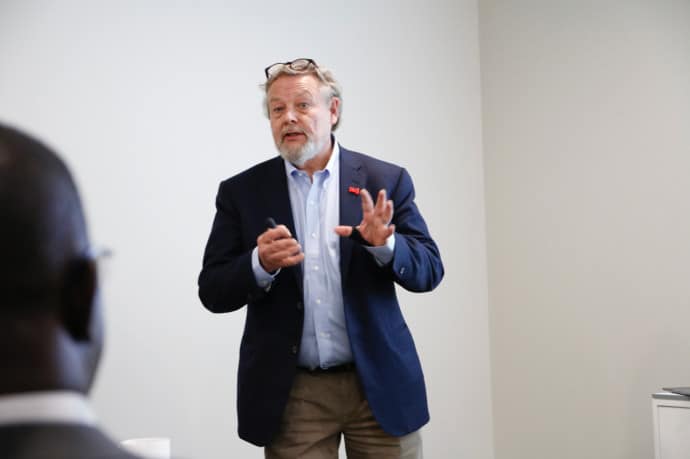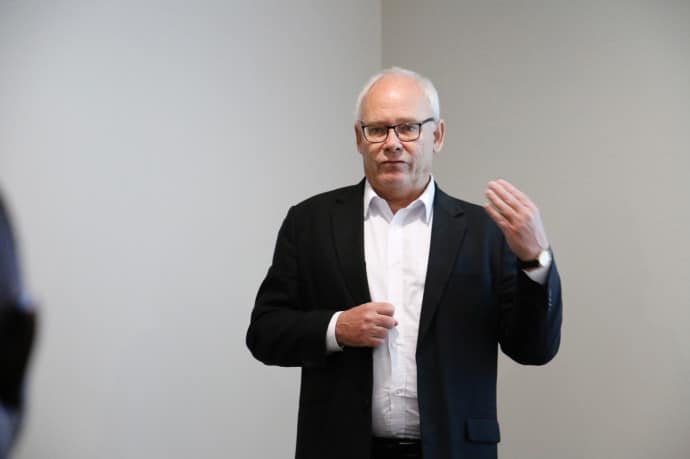“It’s about excellence in research,” said Göran Sandberg, Executive Director of the Wallenberg Foundations. “Unlocking the potential of ideas, people and society. It’s a quest for knowledge and pushing the boundaries. The possibilities are endless.”
Sandberg and Peter Wallenberg Jr, the Chairman of the Wallenberg Foundations, were presenting a seminar at the Stellenbosch Institute for Advanced Study (STIAS) explaining the role and extent of the Wallenberg Foundations and their ongoing involvement and commitment to STIAS.
The Wallenberg Foundations collectively refer to 16 Swedish, non-profit, public and private Foundations, either established by members of the Wallenberg family or created in honour of family members. The Knut and Alice Wallenberg Foundation, established in 1917, is one of the largest private funders of research in Europe, and ranks among the top three in the world in bibliometric terms.
The Foundation’s grant policy focuses on research performed by individuals and on grants for research projects with high scientific potential. Since 1917 the Foundations have awarded more than 3.5 billion Euro in grants. In 2018 grants provided by the three largest of the Foundations totalled 240 million Euro.
The Foundations focus mainly on funding research in the fields of medicine, technology and the natural sciences, although grants are also given for research in the social sciences, humanities and archaeological studies.

“Our model is about making money work. Directing dividends back into the Foundations,” said Peter Wallenberg Jr. “80% goes into research, 20% is reinvested.”
“The focus is on basic science, excellence, individuals and freedom with an understanding that research is never a failure, as we are always learning,” he continued.
Grants are made directly to research projects, Wallenberg Academic Fellows, Senior and Junior Scholars with long-term support of up to ten years as well as to strategic areas, infrastructure of national importance and science centres. New post-doc programmes have also commenced at Nanyang Technology University in Singapore and the Massachusetts Institute of Technology.
At any one time there are up to 1000 PhDs being financed undertaken by scholars from all over the world working at Swedish universities.
Subject areas of particular interest include mathematics, automisation and digitisation, artificial intelligence and quantum technology research.
“The focus on automatic systems programming and artificial intelligence, which currently involves recruitment of 80 new research groupsand 350 PhD students, is one of the largest research programmes in Europe and an important collaboration between academia and business,” said Sandberg.
“It’s important that we understand the rapidly changing areas of digitisation and AI, and identify the new needs caused by digital change,” said Wallenberg Jr. “New careers and competencies will develop which we can’t even imagine now.”
“There is a need to build critical mass in these areas,” said Sandberg. “We are not necessarily going to solve current problems but are building competencies for the future.”
 Göran Sandberg, Executive Director of the Wallenberg Foundations, during his presentation at STIAS
Göran Sandberg, Executive Director of the Wallenberg Foundations, during his presentation at STIAS
Country specific and global focus
Founded on the principle of Landsgangligt, meaning for the betterment of Sweden, the Foundations do still focus on specific areas of interest to the country including Forestry.
“Forestry constitutes 40% of Sweden’s net exports. In 2018 680 million Swedish Krona were invested in forestry research,” said Sandberg, “Into biology and genetics all aimed at increasing the productivity of forests in an environmentally friendly manner as well as new materials from wood. With more people and less land we have to produce more on less. Although the initial focus is forestry this research could also influence future plant and therefore food production in other areas of the world.”
Peter Wallenberg Jr was quick to point out that the sixth generation of the family who will be the next leaders of the Foundations continuously point to the importance of embracing internationalisation and the global reach of all the work.
“They understand the importance of fully incorporating what is around you as part of your thinking and planning,” he said.
As an example in this regard the Foundations have recently established a programme aimed at financing the ongoing education and integration of refugees into Sweden.
“Sweden took in more refugees than any other European country,” said Wallenberg Jr. “We wanted to find a way to help with their education and integration. We are linking with other organisations with limited funds and looking to fast-track these processes through activities like internships and summer schools.”
“Sweden would not be where it is today without the immigrants who came in from the 1950s onwards. Immigrants are part of the future of Sweden. It’s about valuing people. Previously they were viewed from a problem mind set. We want to show the value of the competencies that come into the country. For example, Sweden has a shortage of 20 000 teachers yet immigrant teachers have to wait up to five years before they can teach. This must be improved.”
Involvement in Africa
For the past 15 years the Foundations have had a substantial involvement in Africa through their funding of STIAS of which they are the major funder along with Stellenbosch University.
Peter Wallenberg Sr, former Chairman of the Foundations, made the initial decision to allocate funds for the STIAS Wallenberg Research Centre and to support the STIAS programme. The Wallenberg Foundations have been, and remain, a major sponsor of STIAS, contributing about 50% of the annual budget.
“My father was bitten by the African bug when he spent time in the then Rhodesia in the late 1950s,” said Wallenberg Jr. “He wanted to find ways of contributing, of learning more, bringing Africans and others together to learn from each other. Slowly but surely we have found a way to do this.”
The Wallenberg Foundations remain committed to the long-term support of STIAS incorporating the fellowship programme including Iso Lomso as well as the PhD programme which has produced 30 PhDs thus far – many in the humanities and social sciences – with 60% from other African countries.
“We see the Iso Lomso Fellowships which focus on younger African scholars as a key focus,” said Wallenberg Jr.
The Foundation will also be hosting Nobel Symposia annually at STIAS from 2020 onwards. The first time this is happening outside of Sweden. These will place young academics in the same room as Nobel Laureates with the first one in the field of medicine.
An integral part of the STIAS model is the interdisciplinary nature of the interactions and the cross pollination of ideas. This is an approach strongly endorsed by the Foundations.
“It’s something we need to keep pushing in the best possible way,” said Wallenberg Jr. “Cross pollination and communication are very important. It’s of benefit to everyone to get out of their boxes.”
“Interdisciplinary cross pollination is hard to achieve,” added Sandberg. It’s not historically how universities and academics work but we find increasingly that our younger scientists want to work together and refuse to be divided up.”
“Collaboration is the secret agenda of STIAS,” said Bernard Lategan, the Founding Director of STIAS. “It’s about a spirit of generosity – the more you share the more able everyone is. It’s not about bringing a gift to ‘poor Africa’. It’s an equal conversation between the best in the world. No thoughts are barred, no positions incorrect, it’s an open space.”
“Across all our work we aim to find the best individuals, give them freedom and hope for the best,” added Sandberg.
“Making relatively small investments that hopefully generate huge impact,” added Wallenberg Jr.
Michelle Galloway: Part-time media officer at STIAS
Photographs: Christoff Pauw
